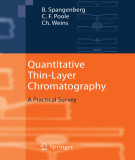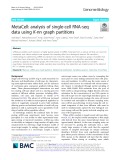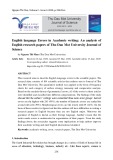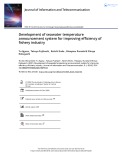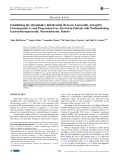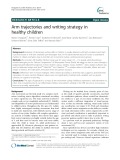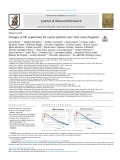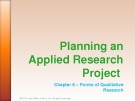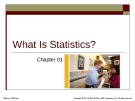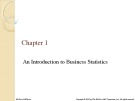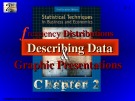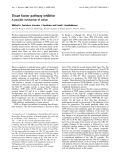
Describing quantitative data
-
Ebook "Quantitative thin-layer chromatography: A practical survey" is widely used particularly for pharmaceutical and food analysis. While there are a number of books on the qualitative identification of chemical substances by TLC, the unique focus here is on quantitative analysis. The authors describe all steps of the analytical procedure, beginning with the basics and equipment for quantitative TLC followed by sample pretreatment and sample application, development and staining, scanning, and finally statistical and chemometrics data evaluation and validation.
 399p
399p  manmanthanhla0201
manmanthanhla0201
 26-02-2024
26-02-2024
 7
7
 1
1
 Download
Download
-
We describe a methodology for partitioning scRNA-seq datasets into metacells: disjoint and homogenous groups of profiles that could have been resampled from the same cell. Unlike clustering analysis, our algorithm specializes at obtaining granular as opposed to maximal groups.
 19p
19p  vielonmusk
vielonmusk
 30-01-2022
30-01-2022
 12
12
 0
0
 Download
Download
-
This research aims to describe English language errors in the scientific papers. The research data consists of 104 scientific articles that authors sent to Journal of Thu Dau Mot University. The quantitative method was applied in the form of frequency charts for each category of surface strategy taxonomy and comparative analysis. Based on the analysis theory of grammatical errors, all of the errors in these articles were identified and classified into different categorizations.
 17p
17p  cothumenhmong11
cothumenhmong11
 05-05-2021
05-05-2021
 32
32
 2
2
 Download
Download
-
Development of seawater temperature announcement system for improving efficiency of fishery industry
In this paper, we describe our system and describe its functions. Moreover, we discuss the effectiveness of this system based on the evaluation of user satisfaction with respect to requirements and the investigation of quantitative data, such as the number of effective accesses.
 22p
22p  trinhthamhodang11
trinhthamhodang11
 04-05-2021
04-05-2021
 11
11
 2
2
 Download
Download
-
This study, therefore, tries to build a research model describing the impact of motivations of using SNSs on social e-WOM and the relationship among social e-WOM, consumers’ trust, attitude and purchasing intention via SNSs. After adjusting the measurement scales by a focus group’s discussion, a quantitative survey was executed using the data collected from 509 SNS users and by testing Cronbach’s Alpha reliability, EFA, CFA, and SEM to comment seven proposed hypotheses.
 18p
18p  larachdumlanat129
larachdumlanat129
 19-01-2021
19-01-2021
 29
29
 4
4
 Download
Download
-
The objective of this work was to establish the quantitative relationship between Lanreotide Autogel® (LAN) on serum chromogranin A (CgA) and progression-free survival (PFS) in patients with nonfunctioning gastroenteropancreatic neuroendocrine tumors (GEP-NETs) through an integrated pharmacokinetic/pharmacodynamic (PK/PD) model. In CLARINET, a phase III, randomized, doubleblind, placebo-controlled study, 204 patients received deep subcutaneous injections of LAN 120 mg (n = 101) or placebo (n = 103) every 4 weeks for 96 weeks.
 10p
10p  caothientrangnguyen
caothientrangnguyen
 09-05-2020
09-05-2020
 15
15
 0
0
 Download
Download
-
Evaluation of elementary writing skills in children is usually obtained with high resolution (and high cost) techniques or with low resolution pen-and-paper tests. In this observational study we tested a quantitative method to obtain normative data to describe arm movement during a writing precursor gesture.
 6p
6p  vivalanbo2711
vivalanbo2711
 19-03-2020
19-03-2020
 15
15
 2
2
 Download
Download
-
The aims of this study were to provide life expectancy (LE) estimates of cancer patients at diagnosis and LE changes over time since diagnosis to describe the impact of cancer during patients’ entire lives. Cancer patients’ LE was calculated by standard period life table methodology using the relative survival of Italian patients diagnosed in population-based cancer registries in 1985–2011 with follow-up to 2013.
 7p
7p  trinhthamhodang1
trinhthamhodang1
 14-11-2019
14-11-2019
 13
13
 0
0
 Download
Download
-
The Cenozoic continental deposits of Western Siberia, Eastern Siberia and the Russian Far East are best described on the basis of carpological records. The palaeoclimate evolution has been reconstructed quantitatively (Coexistence Approach) providing inferred data on temperature, precipitation and the mean annual range of these parameters.
 20p
20p  vidonut2711
vidonut2711
 09-11-2019
09-11-2019
 17
17
 1
1
 Download
Download
-
Chapter 6 – Forms of qualitative research. In this chapter students will be able to: Explain the differences between qualitative and quantitative research methods, describe the reasons to use qualitative research, list the nine types of qualitative research designs, distinguish between primary and secondary data, use triangulation in a research design.
 24p
24p  trueorfalse8
trueorfalse8
 07-09-2017
07-09-2017
 57
57
 3
3
 Download
Download
-
After reading the material in this chapter, you should be able to: Briefly describe the unifying themes that characterize the biological sciences; distinguish among the three domains of life, and the eukaryotic kingdoms; distinguish between the following pairs of terms: discovery science and hypothesis-based science, quantitative and qualitative data, inductive and deductive reasoning, science and technology.
 7p
7p  nomoney10
nomoney10
 04-05-2017
04-05-2017
 48
48
 3
3
 Download
Download
-
(bq) part 1 book "business statistics" has contents: statistics and variation, surveys and sampling, displaying and describing categorical data, displaying and describing quantitative data, correlation and linear regression, randomness and probability, random variables and probability models,...and other contents.
 479p
479p  bautroibinhyen23
bautroibinhyen23
 02-04-2017
02-04-2017
 47
47
 4
4
 Download
Download
-
(bq) part 1 book "quantitative methods for business" has contents: managers and numbers, calculations and equations, drawing graphs, collecting data, using numbers to describe data, describing changes with index numbers, finance and performance,...and other contents.
 333p
333p  bautroibinhyen23
bautroibinhyen23
 02-04-2017
02-04-2017
 61
61
 5
5
 Download
Download
-
Chapter 2 - Describing data: Frequency tables, frequency distributions, and graphic presentation. After completing this unit, you should be able to: Organize qualitative data into a frequency table, present a frequency table as a bar chart or a pie chart, organize quantitative data into a frequency distribution, present a frequency distribution for quantitative data using histograms, frequency polygons, and cumulative frequency polygons.
 15p
15p  whocare_e
whocare_e
 04-10-2016
04-10-2016
 39
39
 2
2
 Download
Download
-
Chapter 1: What is statistics? When you have completed this chapter, you will be able to: List ways that statistics is used, know the differences between descriptive and inferential statistics, understand the differences between a sample and a population, explain the difference between qualitative and quantitative variables, compare the discrete and continuous variables, recognize the levels of measurement in data.
 14p
14p  whocare_e
whocare_e
 04-10-2016
04-10-2016
 51
51
 1
1
 Download
Download
-
Chapter 1 - An introduction to business statistics. After mastering the material in this chapter, you will be able to: Define a variable, describe the difference between a quantitative variable and a qualitative variable, describe the difference between crosssectional data and time series data, construct and interpret a time series (runs) plot,...
 11p
11p  whocare_b
whocare_b
 05-09-2016
05-09-2016
 56
56
 1
1
 Download
Download
-
When you have completed this chapter, you will be able to: Organize raw data into frequency distribution; produce a histogram, a frequency polygon, and a cumulative frequency polygon from quantitative data; develop and interpret a stem-and-leaf display; present qualitative data using such graphical techniques such as a clustered bar chart, a stacked bar chart, and a pie chart; detect graphic deceptions and use a graph to present data with clarity, precision, and efficiency.
 68p
68p  tangtuy09
tangtuy09
 21-04-2016
21-04-2016
 63
63
 4
4
 Download
Download
-
Chapter 1 - Introduction: Themes in the study of life. In this chapter, you should now be able to: Briefly describe the unifying themes that characterize the biological sciences; distinguish among the three domains of life, and the eukaryotic kingdoms; distinguish between the following pairs of terms: discovery science and hypothesis-based science, quantitative and qualitative data, inductive and deductive reasoning, science and technology.
 80p
80p  tangtuy02
tangtuy02
 08-03-2016
08-03-2016
 53
53
 7
7
 Download
Download
-
Chapter 6 – Sampling and estimation. This chapter include objectives: Define simple random sampling, define and interpret sampling error, distinguish between time-series and cross-sectional data; state the central limit theorem and describe its importance, distinguish between a point estimate and a confidence interval estimate of a population parameter,...
 27p
27p  allbymyself_10
allbymyself_10
 03-03-2016
03-03-2016
 64
64
 1
1
 Download
Download
-
We have analyzed several mathematical models that describe inhibition of the factor VIIa–tissue factor complex (VIIa–TF) by tissue factor pathway inhibitor (TFPI). At the core of these models is a common mechanism of TFPI action suggesting that only the Xa–TFPI complex is the inhibitor of the extrinsic tenase activity. However, the model based on this hypothesis could not explain well all the available experimental data. Here, we show that a good quantitative description of all experimental data could be achieved in a model that contains two more assumptions....
 16p
16p  research12
research12
 01-06-2013
01-06-2013
 34
34
 4
4
 Download
Download
CHỦ ĐỀ BẠN MUỐN TÌM









